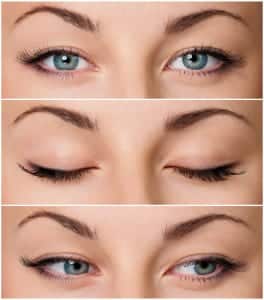Get a More Rested Appearance
Cosmetic eyelid surgery (blepharoplasty) removes excess fat and wrinkled, drooping skin of the upper eyelids. Eyelid surgery also eliminates bags under your eyes and tightens your lower eyelid skin. The result is a more rested appearance.
Dr. Wiener in Chicago has extensive oculoplastic experience. To perform an eyelid surgery, Dr. Wiener uses incisions hidden within the natural folds of the upper eyelid, and just below the lashes of the lower eyelid. If your lower eyelid skin is reasonably tight, the fat that causes the bags can be removed through an incision inside the lower lid leaving no visible scar.

Laser technology can also be used to tighten both the lower and upper eyelid skin without making any incisions at all. This is called a Laser Blepharoplasty and can be done in minutes under local anesthesia or mild sedation.
In addition, loose or low hanging eyelids can be tightened by placing the eyelid, itself, in a better position. This is called a Canthopexy or in some cases, a Canthoplasty. A more extensive (or supercharged Lower Eyelid Lift) is done when the upper cheek is lifted to blend with the lower eyelid. This effectively removes dark circles and the deflated look of the eyelid and upper cheek that occurs with aging. This procedure is called a Mid-Face Lift.
Local anesthesia alone can be used for an Upper Eyelid Lift. Local anesthesia with sedation or general anesthesia is often used for a Lower Eyelid Lift, or a combination of lower and upper eyelid lifting.
What Cosmetic Concerns Can Eyelid Surgery Address?
Laser eyelid surgery can correct the same concerns that are addressed during traditional blepharoplasty surgery. With age, the eyelids often start to look loose, crepe-like, and baggy. These are all indications for blepharoplasty as well as laser blepharoplasty, which achieves very similar aesthetic outcomes but using different incisions technique.
Who Is A Candidate for A Blepharoplasty?
Most healthy adults who want to rejuvenate the appearance of their eyes can be good candidates for the blepharoplasty procedure. To determine candidacy, the doctor performs a thorough consultation, medical history, and examination of the eyes and surrounding structures. The eyes are not alone in their relevance to facial aging and overall appearance. They relate to the temples, the forehead, the eyebrows, and more. For this reason, the doctor cannot evaluate the eyelids as an independent facial feature. Rather, he observes how the eyes serve the overall facial aesthetic when evaluating the value of blepharoplasty as a standalone procedure. In some cases, patients combine their laser blepharoplasty with a brow lift or injectable treatments.
Blepharoplasty may most often be sought by individuals seeking to improve the signs of aging. However, age is not a determining factor on its own. While this laser procedure can eliminate undereye bags, sagging upper eyelid tissue, and other signs of aging, these concerns may exist in adults as young as their thirties. More than age, the doctor observes the condition of the skin and factors that could present potential concerns for complications. Ideal surgical candidates do not smoke and do not have existing medical conditions that could impair their ability to heal well. If pre-existing conditions exist, the doctor may recommend a suitable alternative to blepharoplasty.
What Is The Difference Between Conventional Eyelid Surgery & Laser Eyelid Surgery?
The laser blepharoplasty procedure is nearly identical to traditional eyelid rejuvenation surgery except in the way that incisions are made. During traditional blepharoplasty, the doctor uses a surgical scalpel to make incisions and trim excess tissue. During laser blepharoplasty, "cuts" are made using a precision laser instrument. The benefit of laser technology in this procedure is that the heat from the laser cauterizes (seals) blood vessels at the same time it makes the necessary incisions.
How Is The Procedure Performed?
Laser eyelid rejuvenation is often performed in the office using local anesthesia. The procedure can take 30 to 60 minutes depending on the factors in your particular case. The lower or upper eyelids alone may take little more than half an hour, whereas a complete blepharoplasty that treats the upper and lower eyelids simultaneously requires more time. After administering the anesthetic and confirming its effects, Dr. Wiener uses a handheld laser device to create incisions from a beam of laser energy. Focusing on the upper or lower eyelid area, he then repositions, trims, or removes excess tissue as needed to acheive natural-looking curvature and tightness. The incisions made by the laser device are closed using sutures.
Is It Painful?
No. Laser blepharoplasty, like traditional blepharoplasty, is not painful. The appropriate use of a local anesthetic or general anesthesia ensures that the body does not send pain signals to the brain. Patients who undergo the procedure with a local anesthetic may feel some movement in the surgical area. This is similar to feeling the dentist work on an anesthetized tooth to repair a cavity. The process is not without sensation but it does not hurt. Because the laser device is so precise in its creation of incisions, many patients feel very little discomfort even after their procedure.
How Long Is The Recovery Time?
Blepharoplasty recovery can occur over up to two weeks. Using the laser device tends to decrease post-surgical side effects. However, patients can expect mild to moderate bruising, some swelling or puffiness on the eyelids, water eyes, and temporary double vision. Patients are advised to rest for the first few days after their procedure and gradually begin to resume normal activities as these side effects subside. Strenuous activities and smoking should be strictly avoided for at least two weeks after laser blepharoplasty. If discomfort occurs, patients can manage their comfort with an over-the-counter medication like acetaminophen. NSAIDs like ibuprofen should be avoided. While laser blepharoplasty is extraordinarily precise and conservative, it is imperative that patients follow their post-operative care instructions in order to avoid prolonged healing and an increased risk of infection.
Will There Be Any Visible Scars After The Procedure?
We expect minimal scarring after the laser blepharoplasty procedure. The tiny incisions may look pink and slightly raised during the initial stage of healing after surgery. The lines begin to fade right away due to the way in which the incisions are made simultaneous to the cauterization of blood vessels on the eyelids. Over time, as new collagen repairs the skin around the incisions, these lines fade to become nearly invisible. Due to the positioning of the incisions in the natural creases of the eyelids, scars are usually hidden from view, so patients need not worry about disguising them as the skin heals.
Are There Any Risks Associated With Eyelid Surgery?
Like traditional blepharoplasty, laser blepharoplasty carries some degree of risk. Common risks include:
- Bleeding (although the use of the laser significantly reduces this)
- Infection
- Eye irritation
- Blurred vision
- Difficulty closing the eyes fully
- Injury to the eye muscles
- Skin discoloration
Dr. Wiener takes great care to confirm that each patient is a good candidate for their eyelid rejuvenation procedure. During the consultation, risks are discussed in more detail, and patients can ask questions to help them understand the minimal degree of risk involved.
Recovery from Eyelid Surgery
After eyelid surgery, patients should expect some degree of bruising and swelling which may persist for 7 to 10 days. Cold compresses are used extensively for the first several days after surgery. Sutures come out for five days, and you should be back to work within 7 to 10 days. A mild degree of swelling may persist for several weeks after surgery. For more extensive procedures such as the Mid-facelift, some degree of swelling may persist for a longer period of time.
Most Commonly Asked Questions about Eyelid Surgery (Blepharoplasty):
Eyelid surgery scars are hidden within the natural folds of the upper eyelid as well as just below the lashes of the lower eyelid. Once healed, these scars are very difficult to see, though there will be a permanent mark in these areas. Eyelid surgery scars continue to fade and soften with time. Incisions done inside the lower eyelid are impossible to see, and laser blepharoplasty also leaves no visible scars.
Most eyelid surgery patients have some degree of swelling that lasts for 7 to 10 days. However, there may be subtle amounts of swelling that persist for several weeks or months after the surgery. Often, this persistent swelling is very mild and difficult to see.
Typically, after 7 to 10 days most patients can return to social situations. Make-up can be worn 5 to 7 days after surgery and the use of cold compresses will help minimize bruising and swelling. There may, however, be some degree of swelling that persists beyond the 7 to 10 day period.
Often light, low-impact exercise can begin within three weeks of eyelid surgery. This would include a stationary bike, elliptical machine, or brisk walking. More strenuous workouts will have to wait until 6 weeks after eyelid surgery.
Within 5 to 7 days after eyelid surgery, makeup can usually be worn.
As with any surgery, there are risks and these will be discussed in complete detail by Dr. Wiener during your consultation. Some of these risks may include bleeding, (hematoma), poor scarring or lid asymmetry. However, it is unlikely that these types of complications will occur.
To read more about eyelid surgery and our other offered services, visit The Art of Plastic Surgery’s blog!
Call us today!
Dr. Gregory Wiener proudly provides Chicago, IL with advanced Eyelid Surgery (Belpharoplasty) procedures. Call 773.763.3990 to schedule an appointment or fill out a Contact Form here!

